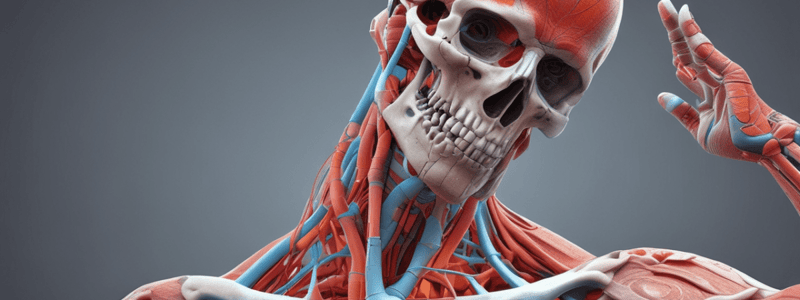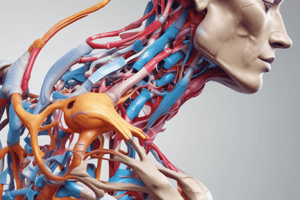Podcast
Questions and Answers
Active movement at a joint is caused by muscular contraction.
Active movement at a joint is caused by muscular contraction.
True (A)
Passive movement at a joint is caused by muscular contraction.
Passive movement at a joint is caused by muscular contraction.
False (B)
Osteokinematics describes the motion of bones relative to the three cardinal planes of the body: Sagittal, Frontal, and Horizontal.
Osteokinematics describes the motion of bones relative to the three cardinal planes of the body: Sagittal, Frontal, and Horizontal.
True (A)
Degrees of Freedom in a joint refer to the number of permitted directions of linear motion allowed.
Degrees of Freedom in a joint refer to the number of permitted directions of linear motion allowed.
Greater degree of freedom in a joint system implies greater stability.
Greater degree of freedom in a joint system implies greater stability.
Accessory motion within a joint structure is considered angular movement.
Accessory motion within a joint structure is considered angular movement.
Excessive translation of a bone relative to the joint may indicate normal joint health.
Excessive translation of a bone relative to the joint may indicate normal joint health.
A significant reduction in translation in a joint may indicate pathologic stiffness.
A significant reduction in translation in a joint may indicate pathologic stiffness.
The size of the motor unit does not influence the order in which it is recruited by the nervous system.
The size of the motor unit does not influence the order in which it is recruited by the nervous system.
The process of modulating the force produced by muscle fibers based on the discharge rate of action potentials is known as rate coding.
The process of modulating the force produced by muscle fibers based on the discharge rate of action potentials is known as rate coding.
If a muscle fiber relaxes completely before the subsequent action potential, the second twitch generates a force higher than the first twitch.
If a muscle fiber relaxes completely before the subsequent action potential, the second twitch generates a force higher than the first twitch.
Muscle twitches summate and generate a greater peak force if the next action potential arrives after the preceding twitch has relaxed.
Muscle twitches summate and generate a greater peak force if the next action potential arrives after the preceding twitch has relaxed.
Muscle fibers innervated by small motor units classified as S have fast twitch responses.
Muscle fibers innervated by small motor units classified as S have fast twitch responses.
SO fibers are characterized by their slow and oxidative histochemical profile.
SO fibers are characterized by their slow and oxidative histochemical profile.
Soleus muscle fibers are prone to fatigue quickly.
Soleus muscle fibers are prone to fatigue quickly.
The Henneman Size Principle allows for sudden and uncontrolled increments in force development.
The Henneman Size Principle allows for sudden and uncontrolled increments in force development.
First Class Levers have the Axis of Rotation between two opposing levers.
First Class Levers have the Axis of Rotation between two opposing levers.
In a Second Class Lever, the muscle possesses less leverage than the External Force.
In a Second Class Lever, the muscle possesses less leverage than the External Force.
Third Class Levers are the most efficient type of musculoskeletal lever.
Third Class Levers are the most efficient type of musculoskeletal lever.
Mechanical Advantage for 1st Class Levers is always less than 1.
Mechanical Advantage for 1st Class Levers is always less than 1.
In a Second Class Lever, the Axis of Rotation is at one end of a bone.
In a Second Class Lever, the Axis of Rotation is at one end of a bone.
The musculoskeletal system functions as the force producers are bones.
The musculoskeletal system functions as the force producers are bones.
Mechanical Advantage is calculated as the ratio of Internal Moment Arm to External Moment Arm.
Mechanical Advantage is calculated as the ratio of Internal Moment Arm to External Moment Arm.
Third Class Levers are the least common type of musculoskeletal lever.
Third Class Levers are the least common type of musculoskeletal lever.
3rd Class Levers always have an MA greater than 1.
3rd Class Levers always have an MA greater than 1.
The human body contains over 200 skeletal muscles.
The human body contains over 200 skeletal muscles.
Muscles mainly serve a stability function by controlling the movement of a bony lever around a joint axis.
Muscles mainly serve a stability function by controlling the movement of a bony lever around a joint axis.
When a joint is in a close-packed position, the stability role of the muscles is increased.
When a joint is in a close-packed position, the stability role of the muscles is increased.
Skeletal muscles are responsible for heat production during cold stress.
Skeletal muscles are responsible for heat production during cold stress.
Muscle forces have only rotatory components and no translatory components.
Muscle forces have only rotatory components and no translatory components.
Third-class levers are considered efficient due to their mechanical advantage of greater than 1.
Third-class levers are considered efficient due to their mechanical advantage of greater than 1.
The main function of muscles includes providing postural support.
The main function of muscles includes providing postural support.
Muscles with large physiologic cross sections can produce more tension than muscles with small cross sections.
Muscles with large physiologic cross sections can produce more tension than muscles with small cross sections.
Passive insufficiency occurs when an inactive muscle is of insufficient length to permit a full range of motion at all joints simultaneously.
Passive insufficiency occurs when an inactive muscle is of insufficient length to permit a full range of motion at all joints simultaneously.
Increasing the number of motor units firing can increase tension in a muscle.
Increasing the number of motor units firing can increase tension in a muscle.
Muscle fibers innervated by small motor units classified as F have fast twitch responses.
Muscle fibers innervated by small motor units classified as F have fast twitch responses.
Passive insufficiency can actually pull the bony lever in the direction of the passive muscle pull.
Passive insufficiency can actually pull the bony lever in the direction of the passive muscle pull.
Active movement at a joint is caused by muscular relaxation.
Active movement at a joint is caused by muscular relaxation.
Third-class levers are considered efficient due to their mechanical advantage being greater than 1.
Third-class levers are considered efficient due to their mechanical advantage being greater than 1.
The Henneman Size Principle allows for sudden and uncontrolled increments in force development.
The Henneman Size Principle allows for sudden and uncontrolled increments in force development.
Passive movement at a joint is caused by muscular contraction.
Passive movement at a joint is caused by muscular contraction.
Flashcards
Active Movement
Active Movement
Movement caused by stimulated muscles in the body.
Passive Movement
Passive Movement
Movement caused by external sources like gravity or stretched tissues.
Osteokinematics
Osteokinematics
The motion of bones in relation to the three cardinal planes: sagittal, frontal, and horizontal.
Degrees of Freedom
Degrees of Freedom
Signup and view all the flashcards
Synovial Joints
Synovial Joints
Signup and view all the flashcards
Henneman Size Principle
Henneman Size Principle
Signup and view all the flashcards
Rate Coding
Rate Coding
Signup and view all the flashcards
S-type Muscle Fibers
S-type Muscle Fibers
Signup and view all the flashcards
Levers in the Musculoskeletal System
Levers in the Musculoskeletal System
Signup and view all the flashcards
Types of Levers
Types of Levers
Signup and view all the flashcards
Mechanical Advantage
Mechanical Advantage
Signup and view all the flashcards
Muscle Function
Muscle Function
Signup and view all the flashcards
Rotatory vs. Translatory Components
Rotatory vs. Translatory Components
Signup and view all the flashcards
Muscle Tension
Muscle Tension
Signup and view all the flashcards
Crossbridge Formation
Crossbridge Formation
Signup and view all the flashcards
Physiologic Cross-Section
Physiologic Cross-Section
Signup and view all the flashcards
Muscle Recruitment
Muscle Recruitment
Signup and view all the flashcards
Joint Stability
Joint Stability
Signup and view all the flashcards
Accessory Movement
Accessory Movement
Signup and view all the flashcards
Gravity's Role in Movement
Gravity's Role in Movement
Signup and view all the flashcards
Fulcrum in Levers
Fulcrum in Levers
Signup and view all the flashcards
Muscle Stabilization
Muscle Stabilization
Signup and view all the flashcards
Degree of Stability
Degree of Stability
Signup and view all the flashcards
Force Production in Muscles
Force Production in Muscles
Signup and view all the flashcards
Muscle Activation via Nervous System
Muscle Activation via Nervous System
Signup and view all the flashcards
Tension Generation in Muscles
Tension Generation in Muscles
Signup and view all the flashcards
Impact of Motor Unit Size
Impact of Motor Unit Size
Signup and view all the flashcards
Cardinal Planes
Cardinal Planes
Signup and view all the flashcards
Study Notes
Movement and Muscles
- Movement of the body or a bone at a joint can be classified as active (caused by stimulated muscles) or passive (caused by external sources such as gravity or stretched connective tissues)
- Osteokinematics describes the motion of bones relative to the three cardinal planes of the body (sagittal, frontal, and horizontal)
Degrees of Freedom and Joint Motion
- Degrees of freedom refer to the number of permitted, independent directions of angular motion allowed at a joint (up to 3 degrees of angular freedom in the 3 cardinal planes)
- Greater degrees of freedom in a joint system may indicate greater instability
- All synovial joints allow some translation (accessory movement) within the joint structure, which is often used to test joint health
Muscle Recruitment and Force Generation
- The size of the motor unit influences the order in which it is recruited by the nervous system (Henneman Size Principle)
- Activating muscles via the nervous system involves rate coding, where the force produced by muscle fibers is modulated by the discharge rate of action potentials
- Muscle fibers innervated by small motor units (S-type) have slow twitch responses and are fatigue-resistant
Levers and Mechanical Advantage
- The musculoskeletal system functions as force producers (muscles) moving levers (bones) with movement taking place at a pivot point or fulcrum (joint)
- Levers are classified into 3 types: first class, second class, and third class, based on the location of the axis of rotation
- Mechanical advantage refers to the ratio of the internal moment arm to the external moment arm
Muscle Function and Structure
- The main function of muscles is mobilizing and stabilizing the human body
- Muscles serve both mobilization and stability functions by producing or controlling movement and resisting extraneous movement of joint surfaces
- Muscle forces have both rotatory (mobility) and translatory (stability) components
Muscle Forces and Tension
- Muscle tension (force) can be increased by increasing the frequency of firing of a motor unit (rate coding) or by increasing the number of motor units firing (recruitment)
- The greater the number of crossbridges formed, the greater the tension generated by muscles
- Muscles with large physiologic cross-sections are capable of producing more tension than those with small cross-sections
Studying That Suits You
Use AI to generate personalized quizzes and flashcards to suit your learning preferences.




